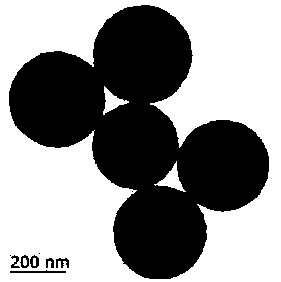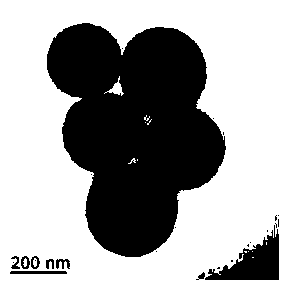Preparation method for petal-shaped molybdenum disulfide hollow mesoporous carbon sphere by in-situ growth
A hollow mesoporous, in-situ growth technology, used in secondary batteries, electrochemical generators, nanotechnology for materials and surface science, etc., can solve problems such as poor semiconductor conductivity, achieve excellent performance, high yield, Simple and environmentally friendly process
- Summary
- Abstract
- Description
- Claims
- Application Information
AI Technical Summary
Problems solved by technology
Method used
Image
Examples
Embodiment 1
[0029] 1. Preparation of hollow mesoporous carbon nanospheres:
[0030] Add 15 mL of absolute ethanol, 3 mL of deionized water, and 0.3 mL of ammonia water into a beaker and perform magnetic stirring, then add 0.3 mL of ethyl orthosilicate to the above mixture, and magnetically stir the mixture for a period of time. Weigh 100 mg resorcinol and 100 mg formaldehyde and add them to the above mixed solution in turn, and react with magnetic stirring for 24 h. After the reaction was completed, it was centrifuged and washed to obtain a solid phase and then dried. Under the protection of argon, the dried product was calcined at 500 °C for 24 hours at a heating rate of 1 °C / min, and then the calcined product was placed in a water bath at 50 °C Etched with 1 M sodium hydroxide solution for 24 h. Finally, the etched product is centrifuged and washed, and the obtained solid phase is dried to obtain hollow mesoporous carbon nanospheres.
[0031] According to the measurement formula, the ...
Embodiment 2
[0035] 1. Preparation of hollow mesoporous carbon nanospheres:
[0036]Add 30 mL of absolute ethanol, 15 mL of deionized water, and 3 mL of ammonia water into a beaker and perform magnetic stirring. At the same time, add 0.3 mL of ethyl orthosilicate to the above mixture, stir the mixture for a period of time, and weigh 100 mg resorcinol and 500 mg formaldehyde were sequentially added to the above mixed solution, and the reaction was carried out by magnetic stirring for 24 h. After the reaction was completed, it was centrifuged and washed to obtain a solid phase and then dried. Under the protection of argon, the dried product was calcined at 700 °C for 5 h at a heating rate of 2 °C / min, and then the calcined product was placed in a 70 °C water bath. Etched with 1.5 M sodium hydroxide solution for 18 h. Finally, the etched product is centrifuged and washed, and the obtained solid phase is dried to obtain hollow mesoporous carbon nanospheres.
[0037] The obtained hollow mesop...
Embodiment 3
[0041] 1. Preparation of hollow mesoporous carbon nanospheres:
[0042] Add 120 mL of absolute ethanol, 30 mL of deionized water, and 6 mL of ammonia water into a beaker and perform magnetic stirring. At the same time, add 0.3 mL of tetraethyl orthosilicate to the above mixture, stir the mixture for a period of time, and weigh 100 mg resorcinol and 1000 mg formaldehyde were sequentially added to the above mixed solution, and the reaction was performed with magnetic stirring for 24 h. Centrifuge and wash after the reaction is completed, obtain the solid phase and then dry it. Under the protection of argon, the dried product is calcined at 800 °C for 2 hours at a heating rate of 5 °C / min, and then the calcined product is placed in a water bath at 90 °C. Etched with 2 M sodium hydroxide solution for 12 h. Finally, the etched product is centrifuged and washed, and the obtained solid phase is dried to obtain hollow mesoporous carbon nanospheres.
[0043] The obtained hollow mesop...
PUM
| Property | Measurement | Unit |
|---|---|---|
| Diameter | aaaaa | aaaaa |
| Surface aperture | aaaaa | aaaaa |
| Diameter | aaaaa | aaaaa |
Abstract
Description
Claims
Application Information
 Login to View More
Login to View More - R&D
- Intellectual Property
- Life Sciences
- Materials
- Tech Scout
- Unparalleled Data Quality
- Higher Quality Content
- 60% Fewer Hallucinations
Browse by: Latest US Patents, China's latest patents, Technical Efficacy Thesaurus, Application Domain, Technology Topic, Popular Technical Reports.
© 2025 PatSnap. All rights reserved.Legal|Privacy policy|Modern Slavery Act Transparency Statement|Sitemap|About US| Contact US: help@patsnap.com



